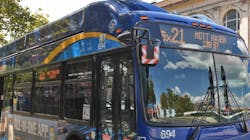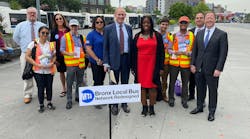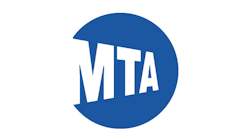MTA presents improvements to redesigned Bronx local bus network
The Metropolitan Transportation Authority (MTA) presented improvements to service and customer satisfaction following the implementation of the redesigned Bronx local bus network in June 2022. The presentation highlighted the redesign strategies that were incorporated to improve speeds, frequency and connections within the Bronx and interborough travel to Manhattan, along with supporting feedback from customer surveys.
The new local bus network consists of 13 modified routes, implementation of two new routes and increased frequency on eight key corridors for 10 routes. The redesign streamlined trips with more direct routing that took advantage of transit priority street designs, adjusted closely distanced bus stops and allowed the MTA to effectively redistribute resources to meet real-time travel patterns of current and future bus customers. All these changes contributed to the positive service improvements outlined.
"The Bronx Local Bus Network Redesign is off to a successful start, showing solid improvements in every measure of bus performance,” said New York City Transit (NYC Transit) President Richard Davey. “The overhaul of the bus networks is a key component of the Faster, Cleaner and Safer Plan to improve service delivery and increase customer satisfaction. I’m thrilled to see customers benefit from measurable results and to hear the impact it has had on their commutes.”
“The data and feedback collected over six months demonstrates the new network is delivering on shorter wait times, faster and more reliable trips,” said NYC Transit Senior Vice President of Buses Frank Annicaro. “The Bronx had one of the slowest bus speeds in the city and is now outperforming citywide trends in Customer Journey Time Performance (CJTP), which measures the percentage of trips that are completed within five minutes of the scheduled time. This is a successful step in delivering better quality bus service.”
Central Bronx crosstown route changes have provided significant improvements in travel time providing quicker, more direct access to opportunities across the borough and into northern Manhattan. The streamlined Bx11 route has connections to the lines at 170 St., providing a more direct option to Manhattan, and with the rerouting to Edward L. Grant Highway, customers are saving 60 to 70 percent, or five to 7 minutes, of their travel time between Mt. Eden Avenue and Manhattan.
Customers traveling between Parkchester and Manhattan on the Bx36 save over 10 minutes in each direction and up to 15 minutes during rush hours as a result of rerouting along East Tremont Avenue and adjustments to closely spaced bus stops.
Bx40 and Bx42 customers traveling along E 180 St. are saving 11 to 12 percent, or three minutes, of their travel time in each direction along E 180 St. The redesigned routing provides direct service along E Tremont Avenue and E 180 St. while avoiding congestion around West Farms Square. The Bx40 now also connects with subway service at the E 180 St. Station.
The 13 routes that were modified saw an improvement in average speeds. Weekday speeds on these routes are four percent faster overall, and morning peak weekday speeds are up five percent, outperforming the system average by seven percent.
The new local bus network includes more buses during off-peak hours, weekends and increases service frequencies on 10 routes. As an example, the Bx11 weekday schedule has been improved to eight minutes or better all day. Additionally, due to the Bx11’s new routing along E 174 St. to Parkchester, the bus route provides new overnight service on both weeknights and weekends.
Overall customer satisfaction in the Bronx on local bus service improved to 61 percent in fall 2022 compared to 59 percent in spring 2022, and the Bronx has outperformed the citywide trends in CJTP comparing fall 2022 to June 2022. The largest improvements in reliability and performance are on the Bx4A along Westchester Avenue, on the new M125 along 125th St. and on the Bx29 to City Island.
From Sept. 8 through Nov. 23, 2022, ridership in the Bronx increased six percent from the rolling baseline, an estimate of seasonally adjusted ridership based on recovery levels as of late spring. Growth can be attributed to both the redesign itself and continued general recovery from the pandemic. Ridership on the Bx18 has more than tripled its baseline, in line with its expanded geographic coverage and added frequency.
Redesigning the city’s bus networks is a community-led project. Customer feedback was critical at every step of the project, including post launch. The MTA project team reviewed public input closely and kept communication with community representatives to ensure the new redesigned network best met the needs of the riders.
Some changes that resulted after launch were the renaming of the Bx18 two-way loop to Bx18A and Bx18B and restoration of 22 bus stops, nine percent of the 258 bus stops removed.
The New York City Department Of Transportation (NYC DOT) has implemented bus priority treatments on six major corridors since 2020, most recently earlier this year. In January, the Bx12 SBS, the busiest bus route in the Bronx, was rerouted along Westchester Avenue to coordinate with the implementation of the new bus lane by Pelham Bay Park station. The reroute avoids a time-consuming loop and serves as a great example of how the MTA works in coordination with NYC DOT to take advantage of transit priority designs.
Additionally, by the end of 2022, the MTA activated bus lane enforcement (ABLE) cameras on three Bronx bus routes:
- Bx12 SBS,
- Bx41
- Bx19
ABLE cameras capture drivers violating busway and bus lane rules in real-time and is a proven effective tool to increase compliance of the bus lanes for a smoother commute.
The Bronx Local Bus Network Redesign launched in August of 2018 and was followed by an Existing Conditions Report, Draft Plan and a Proposed Final Plan, all in 2019. The project was placed on hold for 18 months due to the COVID-19 pandemic and restarted with the announcement of the Final Plan and MTA Board approval to proceed in December 2021. Following final rounds of public outreach and advance notice, the Bronx Local Bus Network Redesign was implemented on June 26, 2022.
“NYC DOT’s bus priority projects are improving the lives of Bronxites across the borough with faster and more reliable service," said NYC DOT Commissioner Ydanis Rodriguez. "We are committed to transit equity and to ensuring that Bronx residents have access to high-quality mass transit, reducing both congestion and emissions. We’re proud to have partnered with MTA on the Bronx Local Bus Network redesign and look forward to more great projects to come.”
“Despite being stalled during the pandemic, we are grateful to the MTA for prioritizing the needs of Bronx commuters by launching the Bronx Bus Redesign,” said Bronx Borough President Vanessa L. Gibson. “With a large segment of our population living in transportation deserts, which can increase their commute time by as much as an hour, we saw travel time along several routes decrease by as much as 40 percent. This is a significant win for our borough and the thousands of Bronx riders that rely on our buses to get to their destination. I want to thank the MTA, transit advocates, community boards and everyone else involved in this initiative for their commitment to transit equity.”
“Bronx commuters deserve the best possible public transportation system,” said New York Sen. Jamaal Bailey. “With the Local Bus Network Redesign, we have taken another step towards this ambitious goal. I’m thrilled the Local Bus Network Redesign has yielded significant systemwide improvements for Bronx commuters with increased reliability, frequency and improved service. I want to thank the MTA and New York City Transit for partnering with the community to hear feedback, implement changes and ensure our system is meeting the needs of Bronxites.”




